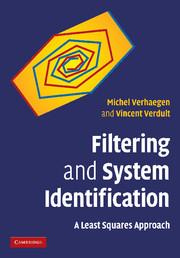Book contents
- Frontmatter
- Contents
- Preface
- Notation and symbols
- List of abbreviations
- 1 Introduction
- 2 Linear algebra
- 3 Discrete-time signals and systems
- 4 Random variables and signals
- 5 Kalman filtering
- 6 Estimation of spectra and frequency-response functions
- 7 Output-error parametric model estimation
- 8 Prediction-error parametric model estimation
- 9 Subspace model identification
- 10 The system-identification cycle
- References
- Index
9 - Subspace model identification
Published online by Cambridge University Press: 14 January 2010
- Frontmatter
- Contents
- Preface
- Notation and symbols
- List of abbreviations
- 1 Introduction
- 2 Linear algebra
- 3 Discrete-time signals and systems
- 4 Random variables and signals
- 5 Kalman filtering
- 6 Estimation of spectra and frequency-response functions
- 7 Output-error parametric model estimation
- 8 Prediction-error parametric model estimation
- 9 Subspace model identification
- 10 The system-identification cycle
- References
- Index
Summary
After studying this chapter you will be able to
derive the data equation that relates block Hankel matrices constructed from input–output data;
exploit the special structure of the data equation for impulse input signals to identify a state-space model via subspace methods;
use subspace identification for general input signals;
use instrumental variables in subspace identification to deal with process and measurement noise;
derive subspace identification schemes for various noise models;
use the RQ factorization for a computationally efficient implementation of subspace identification schemes; and
relate different subspace identification schemes via the solution of a least-squares problem.
Introduction
The problem of identifying an LTI state-space model from input and output measurements of a dynamic system, which we analyzed in the previous two chapters, is re-addressed in this chapter via a completely different approach. The approach we take is indicated in the literature (Verhaegen, 1994; Viberg, 1995; Van Overschee and De Moor, 1996b; Katayama, 2005) as the class of subspace identification methods. These methods are based on the fact that, by storing the input and output data in structured block Hankel matrices, it is possible to retrieve certain subspaces that are related to the system matrices of the signal-generating state-space model. Examples of such subspaces are the column space of the observability matrix, Equation (3.25) on page 67, and the row space of the state sequence of a Kalman filter.
- Type
- Chapter
- Information
- Filtering and System IdentificationA Least Squares Approach, pp. 292 - 344Publisher: Cambridge University PressPrint publication year: 2007
- 5
- Cited by



